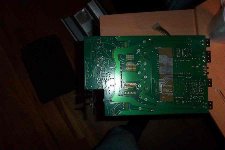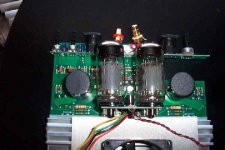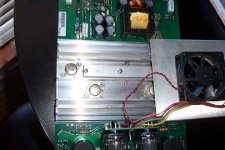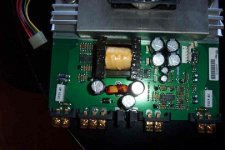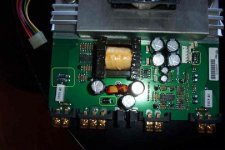OK, I've owned a pair of BK Butler Tube Driver 750's for about 5 years now. I love my amps, and cant even begin to be able to afford to replace them with the new Tube Driver Blue. One still works fine, but the second one has just died. It made no noises, no smell of smoke, and when I pulled the top off of it, there was no visibly damaged components or scorch marks on the PCB. All the cabling is fine, no blown fuses. Where do i start looking to locate why an amp is getting no power. I really need to get my baby back. This is killing me!!!!
any thoughts?can any electronics repair shop do this if its over my head? I cant see it being too dificult to figure out on my own, but could really use some pointers.
Do you have a schematic?
or a voltmeter or a scope? Start by looking at what is different in the working amp from the non-working amp.
or a voltmeter or a scope? Start by looking at what is different in the working amp from the non-working amp.
Ya, I was planning on getting a multimeter and pulling both amps and going over each component one at a time, testing the good one, then the bad one to see if I could figure it out, but was curious if there was an easier way......
Easier Way
Yes, get a schematic and an oscilloscope.
JCoffey said:... was curious if there was an easier way......
Yes, get a schematic and an oscilloscope.
check the input diode....could have just gone...do you have a camera?? take a few shots and post them here...
What should I look for with my Digital multimeter? No, the tubes arent even getting power. The fans not turning on or anything................
do you have a diode check on your DMM?? Do a quickie on them...but to get an accurate measurement...you have to de-solder them first...
I'll be honest I dont know if it does. Its a cheap $20 job from Radio Crack that I got a few years ago and I dont even have the booklet for it. It has DCV, ACV, ohms, DCA, which I know what those all do, and something that looks like a triangle with a line through it pointing right and a vertical line at the tip of the point.
I know I sound like a moron describing it all that way, but I have kinda just learned electronics as I've gone along and needed to. I think if I know what I'm looking for I can fix it, since its probably just a dead part that can can just be replaced. Of course the fun part is figuring out where it is.................
I know I sound like a moron describing it all that way, but I have kinda just learned electronics as I've gone along and needed to. I think if I know what I'm looking for I can fix it, since its probably just a dead part that can can just be replaced. Of course the fun part is figuring out where it is.................
Diode test
A diode test is usually a prt of the ohms function. Unsolder one side of each diode and when you hook up your ohmeter one way is should look like an open and when you hook it up the other way you should measure some conduction. You can get a nice MWW for under $100 these days. Fluke makes very good DMMs.
A diode test is usually a prt of the ohms function. Unsolder one side of each diode and when you hook up your ohmeter one way is should look like an open and when you hook it up the other way you should measure some conduction. You can get a nice MWW for under $100 these days. Fluke makes very good DMMs.
Diode Tester
The meters I've seen that have a diode test function have an image of a diode next to one of the ohms scale ranges. The triangle with an explanation mark in it usually has a voltage rating next to it (600V or 1000V) that lets you know the maximum voltage that can be applied to the meter both differentially and with respect to earth ground.
The meters I've seen that have a diode test function have an image of a diode next to one of the ohms scale ranges. The triangle with an explanation mark in it usually has a voltage rating next to it (600V or 1000V) that lets you know the maximum voltage that can be applied to the meter both differentially and with respect to earth ground.
you should see a reading of about 0.5-0.6 when u put the leads in one way and invalid reading the other...you do have to de-solder the parts to check them properly though...
- Status
- Not open for further replies.
- Home
- Amplifiers
- Solid State
- Need some help with a dead car audio amp......
